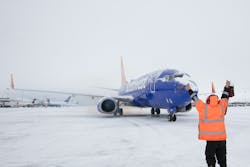5 Actions Southwest Is Taking to Improve Winter Operations
Southwest Airlines Co. today shared overview of prioritized actions being implemented to strengthen the airline's operational resiliency.
As a result of initial assessments conducted by Southwest and aviation consultancy Oliver Wyman, the airline has developed a three-part Tactical Action Plan to boost operational resiliency in key areas across the company. The airline's existing five-year Operational Modernization Plan, which began in 2022, is also underway and focuses on operational investments and organizational alignment to support customers and employees.
"We understand the root causes that led to the holiday disruption, and we're validating our internal review with the third-party assessment. Now, we expect to mitigate the risk of an event of this magnitude ever happening again," said Bob Jordan, Southwest's president and chief executive officer, in a March 14 news release. "Work is well underway implementing action items to prepare for next winter — with some items already completed. I want to thank our employees and customers for their patience and grace, and we're resolved to emerge an even stronger airline."
Looking specifically at challenges with infrastructure, winter equipment and winter weather preparedness, the airline says they have been, or will be, addressed through actions including:
1. Purchasing additional deicing trucks
2. Securing additional deicing pads and deicing fluid capacity at key network locations
3. Purchasing more engine covers and engine heaters for cold weather operations
4. Augmenting winter staffing levels – Southwest was the first U.S. airline to hire back to pre-pandemic total staffing by June 2022, and, going forward, the airline will further augment winter staffing levels — for example, when ground operations employees are limited to the amount of time they can work outside in extreme temperatures.
5. Implementing a new weather application to provide crews with more real-time and dynamic weather indications to enhance deicing holdover times — which determines the time required before aircraft must be deiced again prior to departure.
In addition to Winter Storm Elliot, which was more severe than expected, a driver of the disruption was determined to be the volume of cascading and close-in flight cancellations during the storm that overwhelmed station operations and the airline's crew network and hindered established processes and internal tools. While the airline had existing technology and staffing in place to handle many types of irregular operations, the pace and breadth of disruptions during this extreme event strained the ability to create timely operational solutions. The airline will provide additional communication in the coming weeks, including a microsite summarizing key findings and mitigation actions.
Source: March 14, 2023, Southwest Airlines news release
